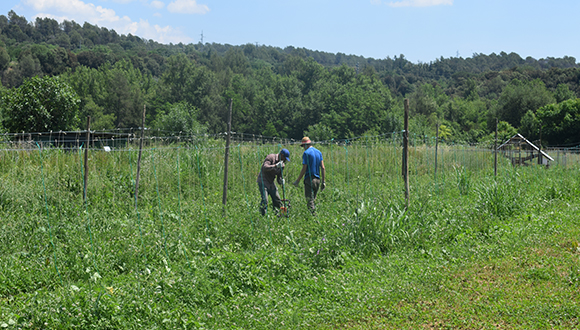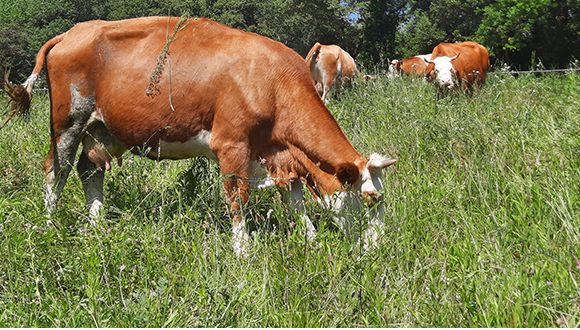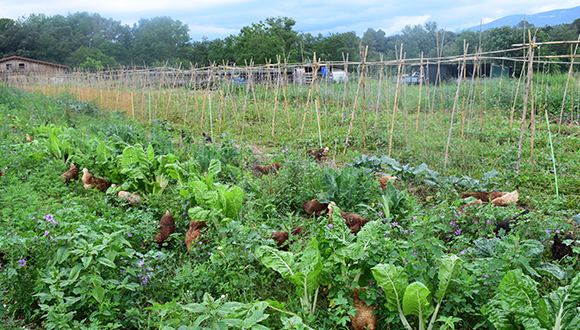A regenerative agriculture vegetable garden absorbs up to 30 times more CO2 per year than a conventional one
The LIFE Polyfarming project has carried out the regenerative agri-food model for five years in an abandoned farm located in Catalonia. After these years, the project has demonstrated its profitability and potential to fight against climate change and rural abandonment. The experience has also resulted in the 'Polyfarming Manual', a regenerative agri-food model guide with a scientific basis, the first in Spain. The Manual and replication sessions of the model in Extremadura and the Basque Country aim to encourage the change towards the regenerative model.
- The results show that if the entire agricultural and grassland area of Catalonia switched to the regenerative model, it would completely offset the annual CO2 emissions of the Catalan agricultural sector.
- Regenerative agriculture focuses on recovering the fertility and quality of the soil naturally, without synthetic fertilisers. In three years, the organic matter in the soil of the pilot farm has doubled and the capacity to retain water has increased by up to 20%.
Every year, agriculture releases 12% of the total CO2 Spanish emissions into the atmosphere. Producing food is essential for our survival, so is reducing emissions. Is there an agri-food model capable of reversing this situation? CREAF, through the LIFE Polyfarming project, funded by the European Commission's LIFE programme, demonstrates with scientific data that the regenerative agri-food model, focused on restoring soil health, is a feasible solution to this global challenge. According to the results obtained over the last three years at the Planeses pilot farm (Girona, Catalonia), a regenerative vegetable garden's fertile soil stores around 30 times more atmospheric carbon per year than a conventional one.
According to the results obtained over the last three years at the Planeses pilot farm (Girona, Catalonia), a regenerative vegetable garden's fertile soil stores around 30 times more atmospheric carbon per year than a conventional one.
In addition, regenerative grasslands, which are managed with grazing animals, sequester about three times more carbon per year than unmanaged grassland. These annual carbon sequestration rates occur during the first six years after switching from conventional to the regenerative agri-food model. After these years, the soil remains a significant sink, as the stored carbon is not released into the atmosphere. On the other hand, this agricultural model has already been shown to emit 40% less CO2 than conventional agriculture by not using pesticides or chemical fertilisers and reducing machinery.

In order to replicate locally and globally the regenerative system tested by Polyfarming, the project holds a workshop today to present the 'Polyfarming System Manual'. An 'alphabet' of regenerative agriculture and livestock farming, it aims to provide tools and knowledge so that anyone interested can replicate it on their own farm. "It is urgent to transform the intensive agri-food model from being one of the main causes of climate change to being a great ally," says project coordinator and CREAF researcher Marc Gràcia. "In fact, we have calculated that if the entire agricultural and pastureland area of Catalonia were to make a change to regenerative practices, the annual CO2 emissions of the Catalan agricultural sector would be completely offset." The expert community claims that the transition from one model to another should be a short-term objective. However, they recognise that the change may be challenging because it implies much social, economic and political support.
Enhancing the soil's life at the centre of the model
This model is named regenerative because it is concerned precisely with regenerating the soil. The aim of regenerative practices is to restore the ground's fertility and keep it moist and in good condition to enhance life, including microorganisms, plants, insects, etc. This way, it will be able to sequester and store a large amount of atmospheric carbon as organic matter. At Planeses farm, soil organic matter has doubled in the last three years. This increase has also improved the water holding capacity of the soil by 15-20% compared to the conventional system.
At Planeses farm, soil organic matter has doubled in the last three years. This increase has also improved the water holding capacity of the soil by 15-20% compared to the conventional system.
"If the soil has more organic matter, it can retain more water, this way, the effect of flooding and erosion due to heavy rainfall is mitigated; also, it helps crops to be productive under severe arid climatic conditions, such as droughts, which are becoming increasingly frequent in the Mediterranean due to climate change," comments Maria Josep Broncano, CREAF technician of the Polyfarming project. In order to achieve these levels of organic matter, the regenerative system uses a circular and minimally invasive production system, "in which the soil is the centre of the system", says Marc.

For example, cows graze in a different patch of pasture each day and take some time to return to that area to not damage the plants by trampling: they fertilise with their droppings, eat the best grass, and return when the grass is at its best again. The chickens and rabbits also move freely through a different pasture area every day, transported in mobile chicken houses and pens. Marc points out that "the plant-animal relationship is essential in the regenerative model, as livestock is a key element in restoring soil fertility". The farm uses no heavy machinery and utilises the forest's resources to nourish and protect the soil while increasing its capacity to absorb or retain water. To do this, they make charcoal or biochar, bury wood logs, spread shredded wood chips (BRF), or fertilise with Bocashi compost, an organic fertiliser obtained from plant and animal waste, or biofertilisers made from mountain plants and microorganisms.
From rural abandonment to profitability
Because the Polyfarming system reduces dependence on market inputs and heavy machinery and uses technologies accessible to all and applicable at different scales, it is an effective formula for restoring agro-silvo-pastoral activity in abandoned Mediterranean mountain areas. "A country without fertile land is not capable of producing food, nor of deciding its own agricultural and food policies. Recovering lost fertility makes it possible to promote food sovereignty and produce quality food for the whole of society without being controlled by large external lobbies," states the project coordinator.

Planeses was an abandoned farm before implementing the regenerative model, where the conventional system would not have been profitable. Today, a few years later, it is a project in which eight people work and that has recovered the agricultural and livestock activity of the farm
MARC GRÀCIA, CREAF researcher and Polyfarming coordinator.
A genuine and demonstrative example: the Polyfarming System Manual
The Manual comprises several chapters that explain the regenerative system from the perspective of soil, forest, grassland, livestock and crops, detailing how to combine and integrate nature resources in an agri-food production model. It also incorporates specific regenerative agriculture and livestock practices and the environmental, productive and economic benefits of applying them. In addition, it includes a section with the financial costs, both the different techniques separately and the total balance. This material resulted from exhaustive documentation, analysis, and evaluation of the real experience of applying the Polyfarming system on the Planeses farm.
The project also has carried out two courses to replicate the regenerative model in two other places in Spain: Extremadura and the Basque Country.
The project also has carried out two courses to replicate the regenerative model in two other places in Spain: Extremadura and the Basque Country. The training was aimed at farmers and ranchers looking for more sustainable ways of producing food, both environmentally and economically. It explained how they could adapt the regenerative model to different environmental conditions and according to the resources available.
"Polyfarming demonstrates that the regenerative model is a real and feasible option. We want this pilot farm and the Manual to serve as examples that facilitate and contribute to change", concludes Marc.
And what is regenerative agriculture?

Regenerative agriculture is a revolutionary new concept based on feeding plants naturally and using only the earth's resources. It is not about going back to the past and doing it the way it was done in the last century. Today there is a broad scientific understanding of how natural processes and plant nutrition work, which the regenerative model has integrated to propose new techniques. The model's focus is the soil and, therefore, the farmer's primary concern is to keep the ground alive and moist. Thanks to the practices mentioned in the previous sections, this model uses the farm's natural resources to achieve soil regeneration: resources from the forest, the grazing animals (with their excrements), and the vegetable garden itself. Regenerative agriculture also protects the soil from any intervention that could affect its biological processes: no tilling, bare or uncovered soil, chemical fertilisers or pesticides are used, among others.







